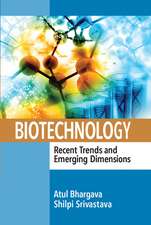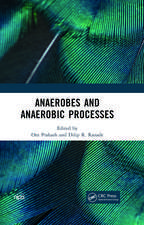Virus Hybrids as Nanomaterials: Methods and Protocols: Methods in Molecular Biology, cartea 1108
Editat de Baochuan Lin, Banahalli Ratnaen Limba Engleză Paperback – 23 aug 2016
Authoritative and practical, Virus Hybrids as Nanomaterials: Methods and Protocols seek to aid new researchers to get involved in this multidisciplinary area.
| Toate formatele și edițiile | Preț | Express |
|---|---|---|
| Paperback (1) | 638.11 lei 6-8 săpt. | |
| Humana Press Inc. – 23 aug 2016 | 638.11 lei 6-8 săpt. | |
| Hardback (1) | 646.62 lei 6-8 săpt. | |
| Humana Press Inc. – 16 noi 2013 | 646.62 lei 6-8 săpt. |
Din seria Methods in Molecular Biology
- 9%
 Preț: 791.63 lei
Preț: 791.63 lei - 23%
 Preț: 598.58 lei
Preț: 598.58 lei - 20%
 Preț: 882.98 lei
Preț: 882.98 lei -
 Preț: 252.05 lei
Preț: 252.05 lei - 5%
 Preț: 802.70 lei
Preț: 802.70 lei - 5%
 Preț: 729.61 lei
Preț: 729.61 lei - 5%
 Preț: 731.43 lei
Preț: 731.43 lei - 5%
 Preț: 741.30 lei
Preț: 741.30 lei - 5%
 Preț: 747.16 lei
Preț: 747.16 lei - 15%
 Preț: 663.45 lei
Preț: 663.45 lei - 18%
 Preț: 1025.34 lei
Preț: 1025.34 lei - 5%
 Preț: 734.57 lei
Preț: 734.57 lei - 18%
 Preț: 914.20 lei
Preț: 914.20 lei - 15%
 Preț: 664.61 lei
Preț: 664.61 lei - 15%
 Preț: 654.12 lei
Preț: 654.12 lei - 18%
 Preț: 1414.74 lei
Preț: 1414.74 lei - 5%
 Preț: 742.60 lei
Preț: 742.60 lei - 20%
 Preț: 821.65 lei
Preț: 821.65 lei - 18%
 Preț: 972.30 lei
Preț: 972.30 lei - 15%
 Preț: 660.49 lei
Preț: 660.49 lei - 5%
 Preț: 738.41 lei
Preț: 738.41 lei - 18%
 Preț: 984.92 lei
Preț: 984.92 lei - 5%
 Preț: 733.29 lei
Preț: 733.29 lei -
 Preț: 392.60 lei
Preț: 392.60 lei - 5%
 Preț: 746.26 lei
Preț: 746.26 lei - 18%
 Preț: 962.66 lei
Preț: 962.66 lei - 23%
 Preț: 860.22 lei
Preț: 860.22 lei - 15%
 Preț: 652.64 lei
Preț: 652.64 lei - 5%
 Preț: 1055.50 lei
Preț: 1055.50 lei - 23%
 Preț: 883.87 lei
Preț: 883.87 lei - 5%
 Preț: 1141.13 lei
Preț: 1141.13 lei - 19%
 Preț: 491.89 lei
Preț: 491.89 lei - 5%
 Preț: 1038.86 lei
Preț: 1038.86 lei - 5%
 Preț: 524.16 lei
Preț: 524.16 lei - 18%
 Preț: 2122.34 lei
Preț: 2122.34 lei - 5%
 Preț: 1299.23 lei
Preț: 1299.23 lei - 5%
 Preț: 1339.12 lei
Preț: 1339.12 lei - 18%
 Preț: 1390.26 lei
Preț: 1390.26 lei - 18%
 Preț: 1395.63 lei
Preț: 1395.63 lei - 18%
 Preț: 1129.65 lei
Preț: 1129.65 lei - 18%
 Preț: 1408.26 lei
Preț: 1408.26 lei - 18%
 Preț: 1124.92 lei
Preț: 1124.92 lei - 18%
 Preț: 966.27 lei
Preț: 966.27 lei - 5%
 Preț: 1299.99 lei
Preț: 1299.99 lei - 5%
 Preț: 1108.51 lei
Preț: 1108.51 lei - 5%
 Preț: 983.76 lei
Preț: 983.76 lei - 5%
 Preț: 728.16 lei
Preț: 728.16 lei - 18%
 Preț: 1118.62 lei
Preț: 1118.62 lei - 18%
 Preț: 955.25 lei
Preț: 955.25 lei - 5%
 Preț: 1035.62 lei
Preț: 1035.62 lei
Preț: 638.11 lei
Preț vechi: 750.72 lei
-15% Nou
Puncte Express: 957
Preț estimativ în valută:
122.12€ • 132.60$ • 102.58£
122.12€ • 132.60$ • 102.58£
Carte tipărită la comandă
Livrare economică 22 aprilie-06 mai
Preluare comenzi: 021 569.72.76
Specificații
ISBN-13: 9781493963249
ISBN-10: 1493963244
Pagini: 245
Ilustrații: X, 235 p. 44 illus., 21 illus. in color.
Dimensiuni: 178 x 254 x 13 mm
Greutate: 0.35 kg
Ediția:Softcover reprint of the original 1st ed. 2014
Editura: Humana Press Inc.
Colecția Humana
Seria Methods in Molecular Biology
Locul publicării:Totowa, NJ, United States
ISBN-10: 1493963244
Pagini: 245
Ilustrații: X, 235 p. 44 illus., 21 illus. in color.
Dimensiuni: 178 x 254 x 13 mm
Greutate: 0.35 kg
Ediția:Softcover reprint of the original 1st ed. 2014
Editura: Humana Press Inc.
Colecția Humana
Seria Methods in Molecular Biology
Locul publicării:Totowa, NJ, United States
Cuprins
Genetic Engineering and Chemical Conjugation of Potato Virus X.- Genetically Engineering Adenoviral Vectors for Gene Therapy.- Simulated Digestion for Testing the Stability of Edible Vaccine, Cucumber mosaic virus (CMV) Chimeric Particle Display Hepatitis C virus (HCV) Peptide.- Using Phage as a Platform to Select Cancer Cell Targeting Peptides.- Bacteriophage T4 Capsid Packaging and Unpackaging of DNA and Proteins.- Templated Mineralization by Charge-modified Cowpea Mosaic Virus.- Polyelectrolyte-modified Cowpea Mosaic Virus for the Synthesis of Gold Nanoparticles.- Tobacco Mosaic Virus Capsid Protein as Targets for the Self-assembly of Gold Nanoparticles.- Tobacco Mosaic Virus Assembled High Aspect Ratio Surfaces.- Phage as a Template to Grow Bone Mineral Nanocrystals.- Genetic Engineering and Characterisation of Cowpea Mosaic Virus Empty Virus-like Particles.- A Programmable Fluorescent Viral Nanoblock: Sensing Made Easy in a Single Step.- Chemical Modification of the Inner and Outer Surfaces of Tobacco Mosaic Virus (TMV).- Engineered Bacteriophage T4 Nanoparticles for Cellular Imaging.- Phage-displayed Single Domain Antibodies as Recognition Elements.- Molecular Targeted Viral Nanoparticles as Tools for Imaging Cancer.
Textul de pe ultima copertă
In Virus Hybrids as Nanomaterials: Methods and Protocols expert researchers in the field detail many of the methods used to study virus for medial and nonmedical applications. These include methods and techniques for genetically engineering viruses for therapeutic purpose and vaccine production, chemically modified viruses for virus-templated nanoparticles production, and genetically engineered or chemically modified viral particles as imaging agents. Written in the highly successful Methods in Molecular Biology series format, chapters include introductions to their respective topics, lists of the necessary materials and reagents, step-by-step, readily reproducible laboratory protocols, and key tips on troubleshooting and avoiding known pitfalls.
Authoritative and practical, Virus Hybrids as Nanomaterials: Methods and Protocols seeks to aid new researchers to get involved in this multidisciplinary area.
Authoritative and practical, Virus Hybrids as Nanomaterials: Methods and Protocols seeks to aid new researchers to get involved in this multidisciplinary area.
Caracteristici
Includes cutting-edge methods and protocols Provides step-by-step detail essential for reproducible results Contains key notes and implementation advice from the experts






















